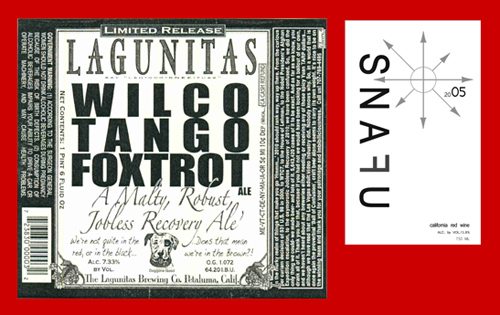We find no FUBAR approvals to date, but here we have WTF ale from Lagunitas, and SNAFU wine from Cartlidge & Browne. Both make liberal use of military slang. Lagunitas does so to express their dismay and confusion about the current state of world affairs. Tango and Foxtrot are well established as the military alphabet codes for T and F. Wilco famously used these codes on a 2002 album, but Whiskey, rather than Wilco, is the correct code for W. Perhaps the Petaluma, California brewer believed TTB would not allow the term “whiskey” on a malt beverage label. Or perhaps they are big Wilco fans. Or perhaps they are just very confused, further to the freewheeling text on the label (tieing in Bush v. Gore, adult videos, and imbibilisciousness). SNAFU, apart from the acronym, is California red wine bottled by Cartlidge & Browne in American Canyon, California. It claims to be the first wine to provide tasting notes via text message.
Continue Reading Leave a Commentmalt beverage
Bemdesor and Bod Liqbt

These brand names don’t exactly roll off your tongue. That won’t stop Anheuser-Busch from bringing them to a TV near you. Keep your eyes peeled for these malt beverage products on TV and in the movies. A few days ago, The Beersage raised good questions about these labels. At first it was not at all clear, but after some looking around, a good reason comes into focus. This year’s approval for Bemdesor does not shed much light, nor does this year’s approval for Bod Liqbt. Go back a few more years, however, and it becomes clear. This 2006 approval for the mellifluous Bemdesor Seqyct quite clearly states:
THIS LABEL IS BEING USED FOR DISPLAY IN MOVIE/TV PROGRAMS ONLY. THE BOTTLE WILL BE FILLED WITH A NON-ALCOHOL PRODUCT IN ORDER TO COMPLY WITH FCC REQUIREMENTS.
A-B has used labels of this sort since at least as far back as 2003; here is an early Bod and here is an early Bemdesor. So far there is no sign of the FCC rule at issue, and it’s not the rule cited here. TTB does require something similar at 27 CFR § 7.54(b)(2): “Any label depicted on a bottle in an advertisement shall be a reproduction of an approved label.” Here are
Soviet-Style Flag Over NH Capitol

You can probably find some examples of American flags on TTB labels. But TTB usually does not allow it, and for that reason you won’t find one on this label. Manchester Brewing explains:
The feds forced us to remove part of the American flag, and replace the stars with a hammer and sickle. It’s the law, doesn’t have to make any sense. Originally, the Kombat ale was a Special Bitter, but it’s moved a bit beyond that.
A better view of the modified flag is here. Is it any wonder that TTB rejected a bunch of Manchester’s labels? Manchester goes on to explain:
Continue Reading Leave a CommentSmacked Down by The Man! The TTB rejected all of our labels! One had a flag over the capitol; it was an American flag but that’s not allowed — so we put a Hammer and Sickle where the stars go, and that’s ok. Also, we used OMFG! on another label, and the government decided that was obscene, even though we protested that it meant Oh My Fairy Godmother and told them we were sticking to that story. So now it says “Censored” over the OMFG, and people tell me they find that funnier.
Beer made with Saliva
We were perusing some lists of shockingly exotic alcohol beverages. Nestled among the Baby Mouse Wine and the Mare’s Milk Wine, we found, at long last, the beer made with human saliva. It is otherwise known as chicha and it goes back thousands of years, to roots in the Andes region. The above video does an excellent job of describing why anyone would chew up maize, add some saliva, and then brew it into beer. The Dogfish site further explains:
Continue Reading Leave a CommentThe most exotic and unique component of this project, from the perspective of the American beer drinker, happens before the beer is even brewed. As per tradition, instead of germinating all of the grain to release the starches, the purple maize is milled, moistened in the chicha-makers’ mouths …, and formed into small cakes which are flattened and laid out to dry. The natural ptyalin enzymes in the saliva act as a catalyst and break the starches into more accessible fermentable sugars. On brewday the muko, or corn cakes, are added to the mash tun pre-boil along with the other grains. This method might sound strange but it is still used regularly today throughout villages in South and Central America. It is actually quite effective and totally sanitary. Since the grain-chewing (known as salivation) happens...
Tags: ingredients, would you drink it?
Liquor Sicle

This Liquor Sicle label features a prominent reference to “Liquor.” This has become rare. Where did the term come from, and where did it go? The Online Etymology Dictionary defines “liquor” this way:
early 13c., likur “any matter in a liquid state,” from O.Fr. licour, from L. liquorem (nom. liquor) “liquid, liquidity,” from liquere “be fluid.” Sense of “fermented or distilled drink” (especially wine) first recorded c.1300. To liquor up “get drunk” is from 1845.
It is semi-ironic that this term is being applied to one of the few TTB products that is not intended to be consumed in a “liquid state.” From way back in 1892, here is a court struggling with the term, and trying to find the distinction between beer and liquor. In a further irony, the term is probably used more commonly, these days, on malt beverages (such as Colt 45) compared to distilled spirits. “Malt liquor” goes back to at least 1937, and Alvin Gluek secured a patent on it in 1948.
Continue Reading Leave a CommentTags: container, non-liquid, policy



